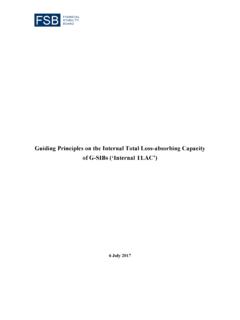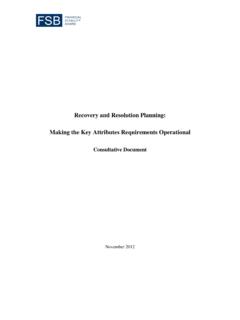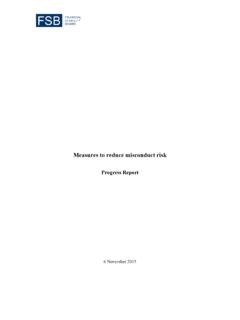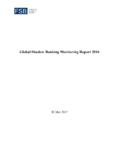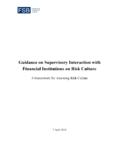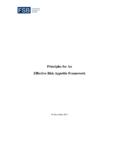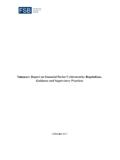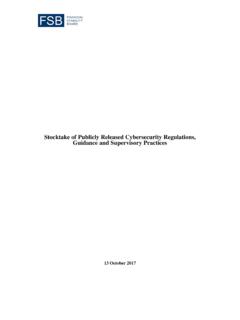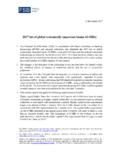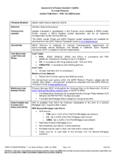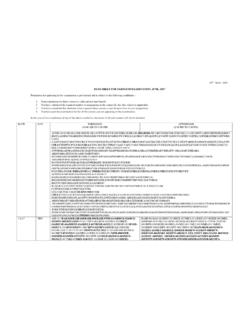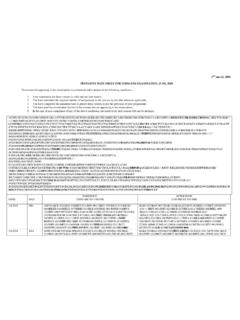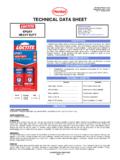Transcription of Principles on Loss-absorbing and Recapitalisation …
1 Principles on Loss-absorbing and Recapitalisation Capacity of G-SIBs in Resolution Total Loss-absorbing Capacity (TLAC) Term sheet 9 November 2015 2 3 Foreword At the St. Petersburg Summit in 2013, the G20 Leaders called on the Financial Stability Board (FSB), in consultation with standard setting bodies, to assess and develop proposals by end-2014 on the adequacy of global systemically important financial institutions Loss-absorbing capacity when they fail. 1 The FSB s agenda for addressing the risks arising from global systemically important financial institutions (G-SIFIs) was set out in 2010, with the goal of reducing both the probability and impact of failure of such firms.
2 It consisted of requirements for assessing the systemic importance of institutions, for additional going-concern loss absorbency, for increased supervisory intensity, for more effective resolution, and for stronger financial market infrastructure. Substantial progress has been made in the implementation of these requirements. However, for home and host authorities and markets to have confidence that systemically important banks are truly no longer too big-to-fail and are resolvable without exposing public funds to loss, they must have confidence that these firms have sufficient capacity to absorb losses, both before and during resolution. The FSB has developed, in consultation with the Basel Committee on Banking Supervision (BCBS) (i) a set of Principles that elaborate on the premise set out in the September 2013 report on Progress and Next Steps Towards Ending Too-Big-To-Fail (TBTF)2 that there must be sufficient Loss-absorbing and Recapitalisation capacity available in resolution to implement an orderly resolution that minimises impacts on financial stability, ensures the continuity of critical functions, and avoids exposing public funds to loss.
3 And (ii) a term sheet that implements these Principles in the form of an internationally agreed standard on the adequacy of total loss absorbing capacity for global systemically important banks (G-SIBs). The term sheet should be read in conjunction with the Principles . It defines a requirement for instruments and liabilities that should be readily available for bail-in within resolution at G-SIBs, but does not limit authorities powers under the applicable resolution law to expose any liability to loss through bail-in or the application of other resolution tools. The Principles and Term sheet form a new international standard for G-SIBs. The FSB will monitor implementation of the standard. It will undertake a review of the technical implementation by the end of 2019.
4 1 See G20 Leaders Declaration 2013 2 4 5 Principles on Loss-absorbing and Recapitalisation Capacity of G-SIBs in Resolution (i) There must be sufficient Loss-absorbing and Recapitalisation capacity available in resolution to implement an orderly resolution that minimises any impact on financial stability, ensures the continuity of critical functions, and avoids exposing taxpayers (that is, public funds) to loss with a high degree of confidence. This is the main guiding principle from which the other Principles flow. Instruments or liabilities that are not eligible as TLAC will still be subject to potential exposure to loss in resolution, in accordance with the applicable resolution law.
5 Calibration of the amount of TLAC required (ii) Authorities should determine a firm-specific Minimum Total Loss-absorbing Capacity (TLAC) requirement for each G-SIB which respects Principles (iii), (iv), and (v). In calibrating the individual requirement for specific firms, authorities will take into account the recovery and resolution plans of individual G-SIBs, their systemic footprint, business model, risk profile and organisational structure. (iii) Each G-SIB should be required to meet a firm-specific Minimum TLAC requirement that is at least equal to the common minimum agreed by the FSB. A common minimum is necessary to help achieve a level playing field internationally and to ensure that there is market confidence that each G-SIB has a minimum amount of Loss-absorbing capacity that would be available to absorb losses and recapitalise it in resolution.
6 (iv) In setting firm-specific Minimum TLAC requirements, authorities should make appropriately prudent assumptions about losses incurred prior to resolution, as well as losses realised in the prudent valuation necessary to inform resolution actions. The FSB Key Attributes of Effective Resolution Regimes for Financial Institutions3 require that resolution action is taken at a sufficiently early point, if there is no reasonable prospect of recovery outside of resolution, with the aim of preserving value. Furthermore, the early intervention of supervisory authorities should moderate those losses. There could therefore be some positive net asset value at entry into resolution.
7 But, balanced against this, experience shows that the valuation in resolution reveals losses that had not previously been realised, that the resolution may be followed by additional losses, and that overly-optimistic risk weightings may need to be revised upward. 3 6 (v) After the resolution transaction, to ensure continuity of critical functions, the entity or group of entities emerging from resolution must meet the conditions for authorisation, including any consolidated capital requirements, and be sufficiently well capitalised to command market confidence. Resolution is not resurrection. But nor is it insolvency: the institution or successor institution ( , bridge institution) has to meet at least the minimum conditions for authorisation in order that supervisors may allow it to continue performing authorised activities, in particular critical functions.
8 Moreover, the reorganisation or solvent wind-down that will be necessary following resolution may require a level of capitalisation above that required by supervisors so that counterparties continue to trade with the resolved firm and provide funding to it. Consideration of potential losses arising from post-resolution reorganisation should also be made. Ensuring the availability of TLAC for loss absorption and Recapitalisation in the resolution of cross-border groups (vi) Host authorities must have confidence that there is sufficient Loss-absorbing and Recapitalisation capacity available to subsidiaries in their jurisdictions with legal certainty at the point of entry into resolution. Without such confidence, host authorities could demand extra resources to be ring-fenced in their own jurisdictions either ex ante or ex post in a resolution.
9 The adverse consequences of such actions, including global fragmentation of the financial system, and disorderly resolutions of failed cross-border firms, should be avoided. To implement an orderly resolution, there must be sufficient flexibility to use Loss-absorbing capacity within a G-SIB where needed. This means that there will need to be a credible mechanism by which losses and Recapitalisation needs may be passed with legal certainty to the resolution entity or entities. Determination of instruments eligible to meet minimum TLAC requirements (vii) Exposing instruments eligible for Minimum TLAC to loss should be legally enforceable, and should not give rise to systemic risk or disruption to the provision of critical functions.
10 Given that TLAC-eligible instruments will need to absorb losses and contribute to Recapitalisation needs in order for an orderly resolution to take place, there is a particular need to ensure that authorities possess the necessary legal powers to expose the TLAC-eligible instruments to loss and that they can exercise their powers without material risk of successful legal challenge or giving rise to compensation costs under the no creditor worse off than in liquidation (NCWOL) principle. Similarly, authorities must be confident that the holders of these instruments are able to absorb losses in a time of stress in the financial markets without spreading contagion and without necessitating the allocation of loss to liabilities where that would cause disruption to critical functions or significant financial instability.
